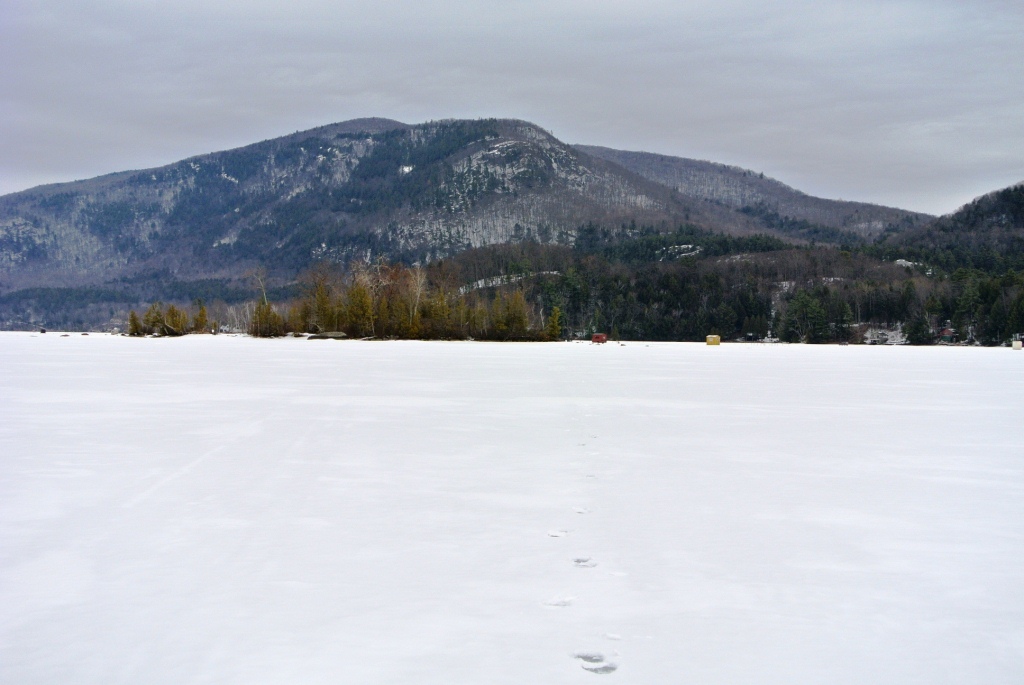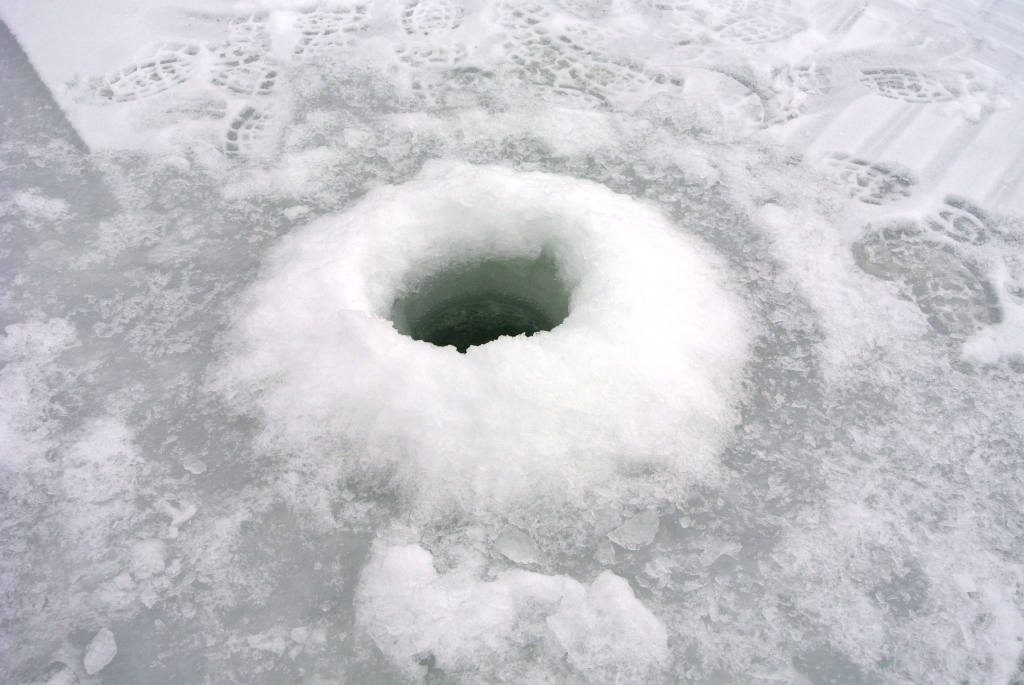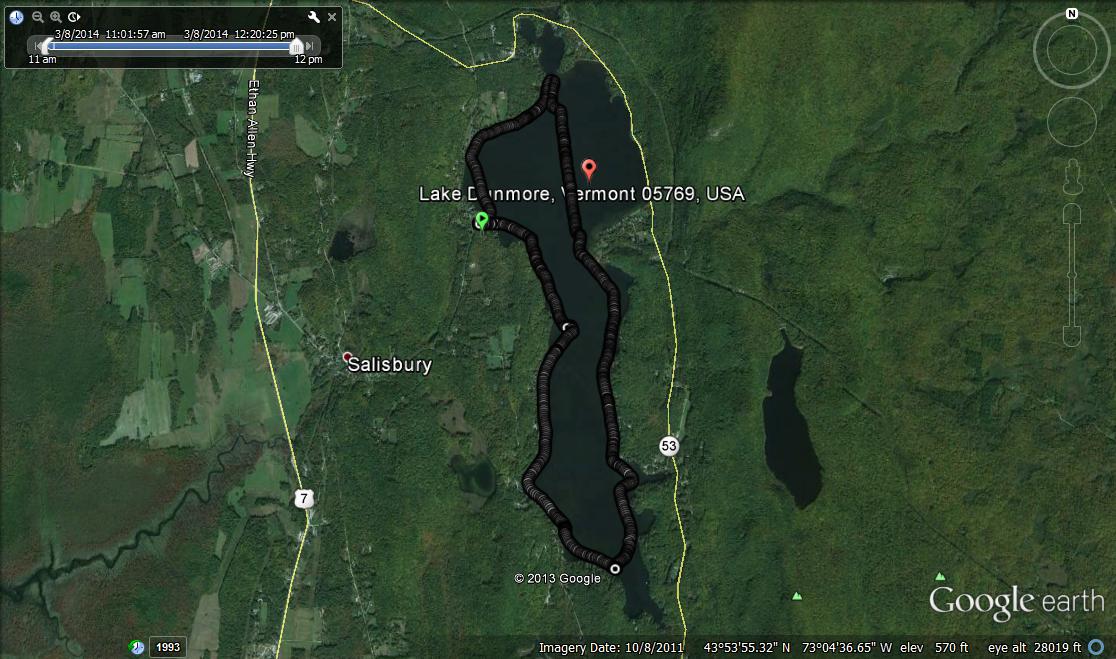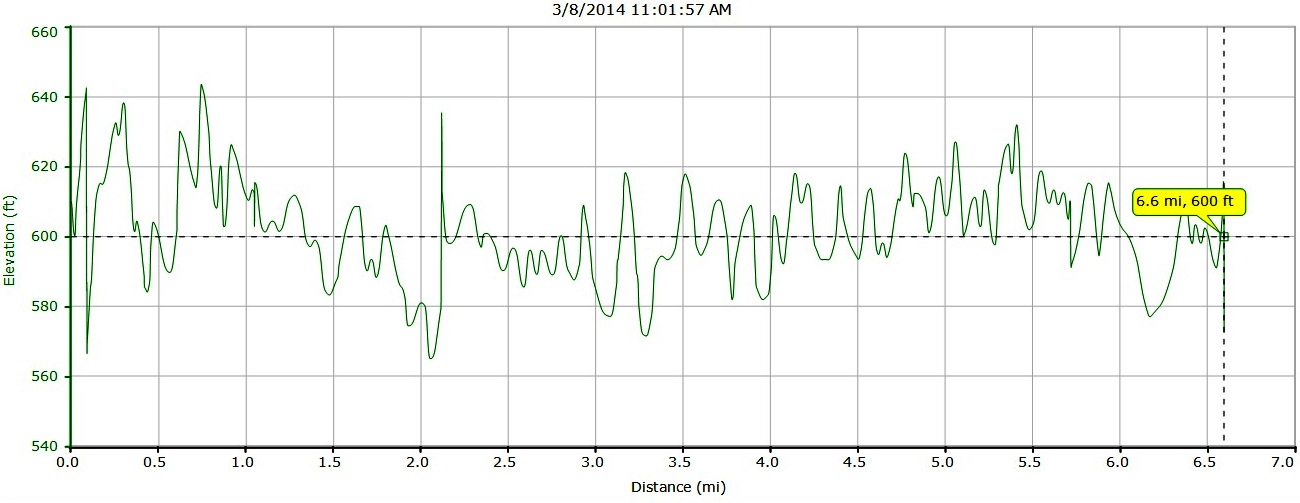Early March can be a tough season for trail running. The snow is at its deepest on the trails, and runners are getting antsy for the arrival of spring, which is still two months away. Chatting with a fellow runner a few days ago, however, he shared his recent epiphany for good clear running – running on the ice covering local lakes to very thick depths this time of year. He suggested Lake Dunmore, so I thought I would give it a try. One prerequisite for this sort of running is a shoe with spikes, or some sort of runner’s crampon to stay upright moving on a mix of ice and snow, and since I had the former, I figured I was all set.
I have not spent much time on open water ice since playing pond hockey as a child. I was a little nervous at first about a longer run on a pretty big lake, but figured that with this year’s very cold winter, good thick ice could be counted on, right? Sharing my running plans with my family, the less adventurous of them (i.e. all of them) double checked to make sure that my will was properly signed, and then acquiesced to my departure. While I spend a lot of time running near, and kayaking on Lake Dunmore over the warmer months, I can’t remember the last time I had journeyed to the lake in the dead of winter. Once, in my young adulthood, I learned the misery of crashing through the ice in water which was not over my head, and a few hundred yards from my lodging. So, my life was never in danger, but it sure was cold!
Approaching the parking lot and launch on the west side of the lake, alongside the docks and beach belonging to Waterhouses, I could see that the lake was busy with the activities of ice fishermen. As you might guess, the calm and patience of the avid fisherman are not common characteristics of somewhat hyperactive runners. While I have not fished since I was a boy (about the same time of life that I played pond hockey!), I can see some of the allure of standing in a Rocky Mountain stream, flyfishing for trout, or perhaps surfcasting from a Gulf Coast beach for – well for whatever kind of fish live in those warmer waters. For the life of me, I cannot begin to imagine the charm and excitement of sitting out in the open, or even a small shack, huddled over a small hole or two in the water on a cold mid-winter day, waiting for the nibble of a lethargic, already half frozen fish. Despite the fact that I have lived in Northern New England now for 33 years of my life, not only have I never undertaken this sort of activity, I really didn’t have a good feel for the popularity of this sport until I saw all of the people out there fishing on Saturday, on this one, rather modest-sized lake alone. To each his/her (mostly his though, from what I see) own. I did get some comfort however, by the presence of such numbers of people, shacks, ATV’s and automobiles out on the lake. If the ice could support someone’s SUV, it could certainly support a scrawny trail runner, right?
I set off towards the southern end of the lake to start my run. Since both of the public landings for kayak access on Lake Dunmore were on the northern end of the lake (the aforementioned state landing alongside Waterhouse’s, and Branbury State Park on the east side), I am not as familiar with the waterfront sights along the southern shores, which require longer paddling times to access in the summer. My first destination however, was the small island in the middle of the lake. I have paddled around this small island on countless occasions, but have never actually stepped foot on it prior to this run. In the late spring, this island is a loon nesting site, and two years ago I had the unexpected pleasure of paddling by the island which was surrounded by birdwatchers armed with binoculars. I had lucked out, and come across that year’s loon chick birthday according to one birdwatcher I pulled up alongside. While I stayed a respectful distance away as required by law, even without my binoculars I could see the loon chicks floating in the water alongside their mother. Returning to the island the next day, excited for another glimpse, I was told by another kayaker that the loons typically move from the island to a quieter corner almost as soon as the chicks are born, and I never saw this family again. There were no loons on the island in early March, of course, but I did use the easy access as an opportunity to traverse this small piece of land before heading back on the ice.
With my spiked running shoes, most of the footing was surprisingly good. In most of the southern part of the lake which has had little vehicle traffic, the ice was smooth and covered by a half inch to inch of coarse windblown snow, which made for good footing. The occasional wind-scoured bare ice patches required that I slow to a careful walk, and on the places where early season car traffic had created ruts in what have been much softer ice (YIKES when you stop and think about it), the footing was also uneven and unyielding.
Continuing south, scooting past mostly well- kept, frequently modern homes which serve as vacation homes for those with greater financial resources than I, I came to one particularly quirky site. A piece of old driftwood at the lake’s edge was adorned with a variety of funky little stone cairns, and when I stopped to examine them more closely, I could see that the property just set back behind them was an uncharacteristically ramshackle log cabin, which looked like something from my old summer camp, rather than as a lake summer home. At that point I realized where I was – the shoreline alongside the “Point Counterpoint” summer camp. This camp is a rather famous summer camp for talented and hard working young musicians.
I had hoped to completely circumnavigate Lake Dunmore on this run, but as I approached the southernmost inlet, I could see that too much of my path was ice, windblown bare, making for difficult footing. So, if you see a portion of the lake omitted from my run on the Google Earth projection down below, that was typically the case. The other major foray away from the shoreline on this run was when I had make a broad sweep away from the delta where the Sucker Brook empties into the lake. This, and the much smaller outlet not far from Waterhouse’s were the only sections of open water that I spied.
The lake, of course, was peppered with ice fishing holes, old and new. Most of the open holes in use were being watched by their owners, and I stayed away out of respect for their desire to actually catch fish. Would a runner plodding by create a racket to spook the fish? Somebody must know the answer to that question, but not I! I did come across a few recently abandoned holes, so my curiosity got the better of me and I peered inside. Peering down these holes, I was comforted to see how thick the ice was – well over a foot deep from what I could see. I briefly considered rolling up my sleeves and inserting my arm down a hole, to feel how deep I had to get before feeling the end of the ice, and then my common sense got the better of me. I also took comfort from the fact that these holes were quite narrow, indicating that there were no sharks to fish for in this lake.
Returning to my car, a few hundred yards from shore, in a section of the lake with no fisherman shacks, by the old Sunset Lodge, I heard what I had been dreading the whole run – the sound of cracking ice, seemingly directly beneath my feet! Was it time to swim? I quickly put on my garishly ugly yellow hat as I sped out of that corner of the lake, hoping that if I crashed through the ice, my would-be rescuers would see my yellow-hatted head bobbing above the otherwise seamless white of the frozen lake, and pull me to my safety. Needless to say, I made it back to shore, my heart pounding a little, and had the courage to ask a returning fisherman about the significance of my frightening experience a few moments before. “Nah – ice makes sounds like that all the time – it’s more than two feet thick now, you were safe I am sure”. Oh. Whew. Relieved and a bit embarrassed.
Overall, this was a 6.6 mile run. It might seem superfluous for me to post my altitude profile for this run, as it was on a lake, and should be….well…flat. I am posting this to illustrate what I already knew about using GPS for altitude. While GPS is incredibly precise for finding locations based on NSEW coordinates, due to the limitations of satellite triangulation, it is not nearly as precise for altitude, as evidenced by the variation of up to 100 feet which it recorded on this run.




